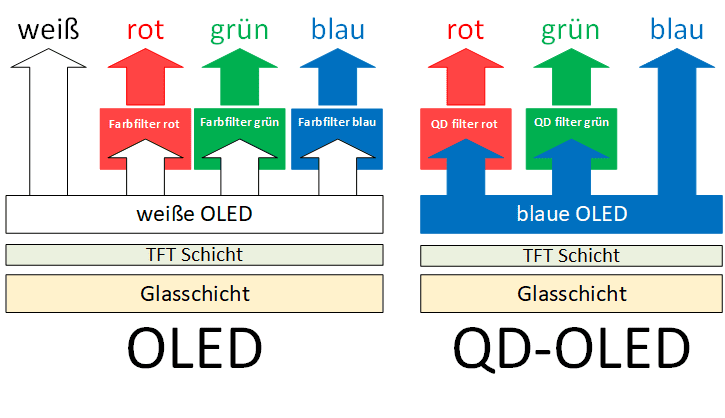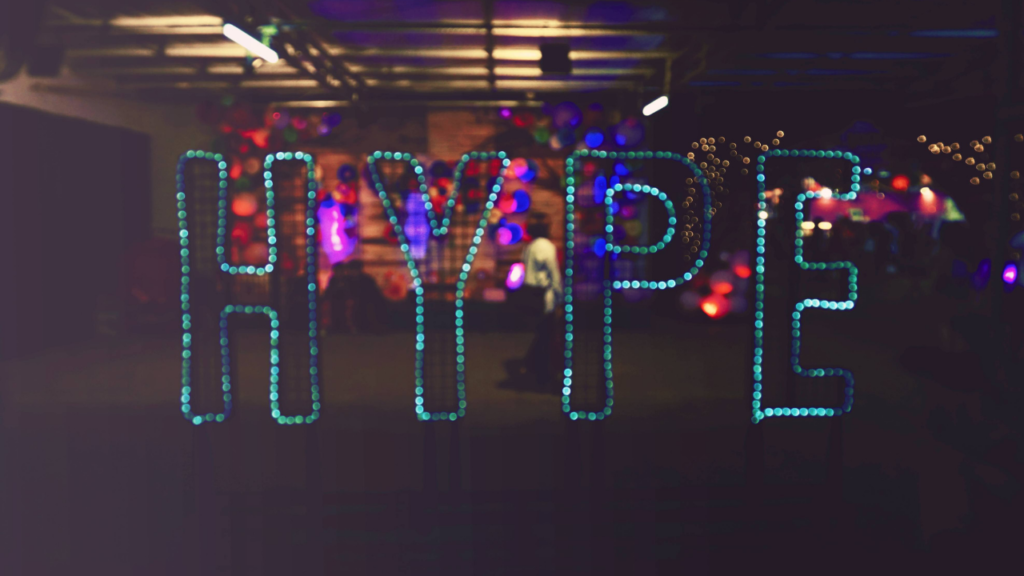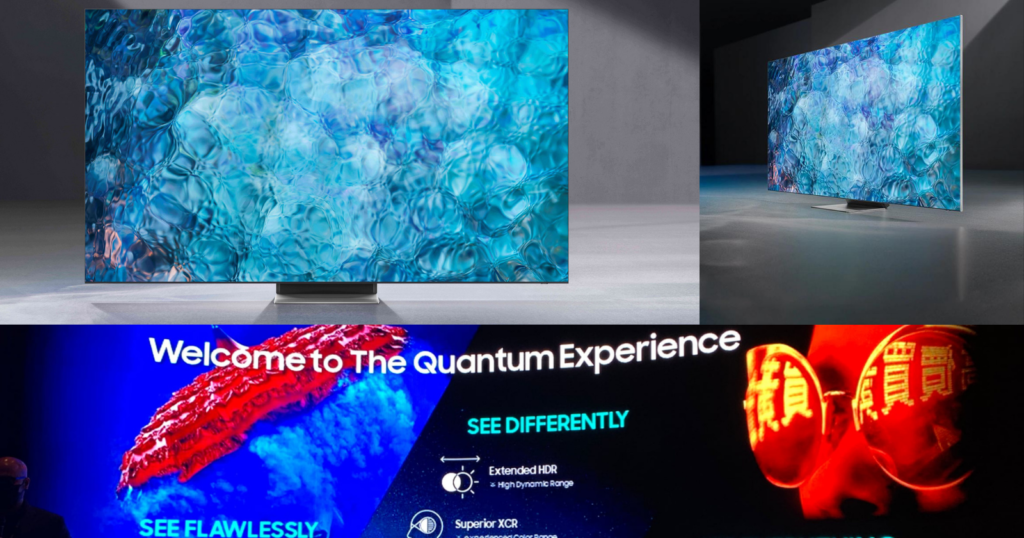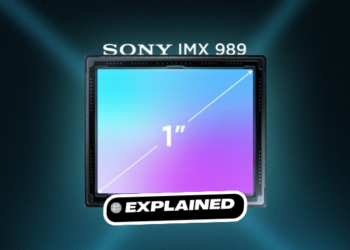QD-OLED: OLED aka Organic Light Emitting Diodes are a series of organic thin films sandwiched between two thin-film conductive electrodes. They emit light when electricity is passed as an immediate response. Right now, they were used to create a series of digital displays including mobile phones, tablets, smartwatches and televisions. The first television sets featuring an OLED display entered the market in 2008 and they were produced by Sony. Since then the monopoly of OLED is continuing to this date. The technology was even adopted into various forms such as AMOLED, PMOLED.
Manufacturers are leaning towards OLED and AMOLED panels due to their thinner, lighter, and more flexible nature than the crystalline layers. Therefore, OLED panels are getting a better marketing cap than LCDs and other display ranges. OLEDs are more power-efficient, have a better picture quality, and also support faster motion response than other display technologies. All these factors are propelling the market growth of OLED. According to a recent study conducted by VMR, it has been observed that the AMOLED Display (a type of OLED display) Market size was valued at USD 7.5 Billion in 2020 and is projected to reach USD 34.84 Billion by 2028. However, this phenomenon might take a serious turn with the introduction of QD-OLED, a next-generation display technology.
What is Quantum Dot Light Emitting Diode (QD-OLED)? How does it work?
QD-OLED stands for Quantum Dot Organic Light Emitting Diode, a next-generation Quantum dot display technology that works based on “Quantum Dot Filter“. It uses Quantum Dots (QD), semiconductor nanocrystals as a base that can produce pure monochromatic red, green, and blue light. This technology has amassed a lot of hype at CES 2022. Samsung quoted the Quantum dot technology is gonna be the next big thing in TVs.
Unlike, OLED which works on having 4 RGBW (Red, Green, Blue, and White) subpixels, QD-OLED does not need the fourth sub-pixel. QD-OLED works on utilising the normal RGB structure. As QD-OLED does not utilise the fourth pixel, the RGB subpixels can be made larger to fill the extra space, increasing their luminous output.

OLED panels are known to produce deep blacks, have wide viewing angles, and have a broad colour range. On the other hand, Quantum dots are known to improve colour purity and peak brightness. What happens when they were mixed? That’s the idea behind QD-OLED. QD-OLED might surely become the next-gen standard for TV’s and other displays since the technology possesses the capability to bring OLED and Quantum Dots together.
QD-OLED: Why so Hype around it?
The concept of using Quantum Dots is nothing new. It has been proposed and used since the 1990s. However, the only reason why QD-OLED is getting hype around it is due to Samsung is pushing it as the next-generation technology. For the past decade, LG Displays has held a monopoly in the panels used for OLED TVs. Long back in 2013, both LG and Samsung jumped into the OLED market at the same time. However, Samsung quickly withdrew from the competition due to its high production costs. LG, however, got hold of it and went sky high with it.
From then on, Samsung has been trying everything under its sleeve to bid farewell against LG’s monopoly. Therefore, Samsung is the driving force behind the QD-OLED technology to put checkmate against LG’s long reign OLED monopoly. The brand even sunk billions into retrofitting an LCD fab in Tangjeong, South Korea, for making QD-OLED displays.

Production Cost & Lifespan: OLED’s Nightmare, QD-OLED’s Pro’s
The biggest reason why Samsung withdrew from the OLED market is due to its sky-high production costs. The OLED panel has organic LEDs that are individually lit. They can be turned ON to show the full colour or fully OFF to show black. However, to do that, the manufacturer need to produce the thinnest panels possible which plummeted the overall cost of manufacturing. Above all, the organic materials used to produce OLED panels requires a higher grade fabrication process which eventually raised the budget for the overall manufacturing process.
The next biggest reason why OLED’s are losing their market is due to their shorter life span. Since the OLED panels are manufactured by using organic materials, the life span of the OLED panel depends upon its level of usage. It’s a known fact that OLED panels suffer from “Burn-in“. Burn-in is a permanent discolouration of your TV. It affects the overall ability of a display to reproduce colours accurately as it ages. Blue OLED panels are more prone to this phenomenon. Quantum dots, on the other hand, are non-organic and therefore got the ability to deliver a longer life span than OLED panels.
Unbeatable HDR
QD-OLED can also offer unbeatable HDR output. It can achieve a brightness level between HDR 1500 to HDR 2000, or the equivalent of 1500 to 2000 candles. Since every manufacturer perfected the LCD fabrication process, production costs of manufacturing QD-OLEDs have been drastically reduced.
Owing to these advantages, Samsung is making its bet on QD-OLED and promoting it to the masses. Samsung first announced the plans to manufacture QD-OLED in 2019, then pushed out the release date a few times. It now seems likely that we will see public demos in early 2022 followed by commercial products later in the year, once the company has geared up for high-volume production. At this point, Samsung can produce a maximum of 30,000 QD-OLED panels a month.

QD-OLED in 2022: How to Get Your Hands on it?
Meanwhile, if you want to experience this groundbreaking technology before anyone, then you are left with a slim number of choices. Right now, only three major brands have announced the consumer versions of QD-OLED products. In CES 2022, Samsung unveiled a 65-inch QD-Display TV. Along with that, Alienware also went into the mix and introduced a gaming monitor that supports the QD-OLED panel. The last one is from Sony. The brand has launched two Bravia XR A95K TVs. All of these brands are yet to reveal the price tags of these products.
Stay tuned for more interesting details about this groundbreaking technology. Follow us on telegram for more interesting tech news coverage.





![Sora Open AI: The AI Video Generating Tool [Explained]](https://curioussteve.com/storage/2024/03/Open-AI-Sora-Explained-120x86.webp)



![Sora Open AI: The AI Video Generating Tool [Explained]](https://curioussteve.com/storage/2024/03/Open-AI-Sora-Explained-350x250.webp)

![Sketch.metademolab: Bring children’s drawings to life [Explained]](https://curioussteve.com/storage/2023/08/Sketch.metademolab-350x250.webp)

Discussion about this post